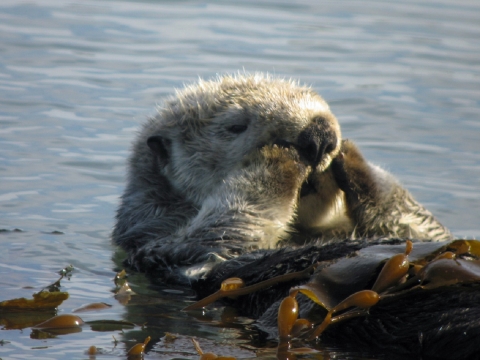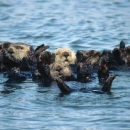For species and biological information, see the northern sea otter species page.
Population History in Washington State
Sea otters have inhabited the northern coasts of the Pacific Ocean since the Pleistocene, about 1 to 3 million years ago. By 1740, when the Bering expedition explored the coasts of the Aleutian and Commander Islands, there were between 100,000 and 300,000 sea otters on the Pacific coast. By 1900, the once profitable commercial harvest of their thick pelts had essentially ceased for the simple reason that it was difficult to locate a sea otter; they had been reduced to 13 tiny remnant populations totaling no more than a few hundred each. In 1911, the International Fur Seal Treaty halted commercial hunting of sea otters.
Once commercial harvest ceased, sea otter populations rebounded and re-colonized much of their former range between Prince William Sound, Alaska west to the Kuril Islands. However, by the 1950s they became extinct along the Pacific coast from Prince William Sound south to Baja California, with the exception of one remnant population in California.
During the 1960s and 1970s, the Alaska Department of Fish and Game reintroduced sea otters into former habitat in Alaska, Canada, Washington, and Oregon in collaboration with other State and Provincial wildlife management agencies. In 1987, otters were reintroduced to San Nicholas Island in southern California. Due to these efforts, sea otter populations in southeast Alaska, British Columbia, and Washington are currently stable or increasing, but have not yet rebounded to pre-commercial harvest levels.
The sea otter population in Washington was listed as “endangered” under Washington State’s Endangered Species Act in 1981, due to its small population size, restricted distribution, and vulnerability. Currently, the Washington sea otter population size is distributed primarily between Pillar Point in the Strait of Juan de Fuca to just south of Destruction Island on the outer coast. A few individual sea otters are occasionally seen in Puget Sound and the San Juan Islands, as well as along the Oregon coast. As of 2010, the Washington sea otter population totals just over 1,000 otters.
Oil spills are the single greatest threat to sea otters throughout their range. Washington’s sea otter population is particularly vulnerable to oil spills because it is concentrated along a relatively small geographic stretch of coastline where vessel traffic is steady.
In December 2004, Washington Department of Fish and Wildlife released their Sea Otter Recovery Plan. The goals of their recovery program are to implement strategies that will ensure a self-sustaining sea otter population in Washington through the foreseeable future and to manage the Washington sea otter stock in a manner consistent with the Marine Mammal Protection Act, other federal and state laws, court rulings, and federal treaties with Native American Tribes.
See the Library Collection for recent population surveys
Process for Obtaining Washington Sea Otter Specimens for Scientific or Educational Purposes
Authorization is required to retain a part or specimen from a dead sea otter. In order to accommodate the use of Washington sea otter parts or specimens for scientific or educational purposes, the Service has developed a Letter of Authorization (LOA) process. The LOA process includes submitting a request letter that includes the following information:
- Name of the organization that will retain possession of the pelt/skeleton;
- The physical location where the item(s) will be retained;
- Name of the individual or institution that will perform the tanning and/or bone cleaning;
- How the item(s) will be retained (i.e., in one piece, cut up, in a display case, etc); and
- The specific scientific or educational purpose for which the item(s) will be used.
The request letter should be addressed and sent to:
Brad Thompson, State Supervisor
U.S. Fish and Wildlife Service
1009 College Street
Suite 215
Lacey, WA 98503
Upon receipt of a request, we will process a Letter of Authorization that enables the requestor to be loaned a pelt and/or skeleton for scientific or educational purposes. However, the Service retains ownership of the item(s).
Permits
Sea otters are protected under the Marine Mammal Protection Act (MMPA) and the Convention on International Trade in Endangered Species of Wild Flora and Fauna (CITES).
In general, it is prohibited under the MMPA to (1) take, (2) import, and (3) possess, transport, sell, export, or offer to purchase, sell, or export marine mammals or their products. In general, exceptions may be made for (1) Pre-MMPA specimens taken before December 21, 1972; (2) International Agreements entered into by the United States before December 21, 1972; (3) Alaska natives; (4) by permit for scientific research, public display, enhancing the survival or recovery of a species, and incidental take in commercial fisheries; and (5) if a waiver is granted by the U.S. Government.
Incidental Take Authorizations
In Washington, the MMPA protects sea otters by prohibiting "take" of these animals. The MMPA provides for specific exceptions to the prohibition on taking, including a provision that allows U.S. citizens to take small numbers of marine mammals incidental to specified activities.
More specifically, Sections 101(a)(5)(A) and (D) of the MMPA authorize the Secretary of the Interior to allow, upon request, the incidental, but not intentional, taking of small numbers of marine mammals (including sea otters) by U.S. citizens who engage in a specified activity (other than commercial fishing) within a specified geographical region provided the total of such taking will have no more than a negligible impact on these marine mammal species and does not have an immitigable adverse impact on the availability of these species for subsistence uses. Two types of authorizations are available. Incidental Take Regulations (ITR) can be issued for up to 5 years; and if the taking is limited to harassment, an Incidental Harassment Authorization (IHA) can be issued for up to 1 year.
More specifically, Sections 101(a)(5)(A) and (D) of the MMPA authorize the Secretary of the Interior to allow, upon request, the incidental, but not intentional, taking of small numbers of marine mammals (including sea otters) by U.S. citizens who engage in a specified activity (other than commercial fishing) within a specified geographical region provided the total of such taking will have no more than a negligible impact on these marine mammal species and does not have an immitigable adverse impact on the availability of these species for subsistence uses. Two types of authorizations are available. Incidental Take Regulations (ITR) can be issued for up to 5 years; and if the taking is limited to harassment, an Incidental Harassment Authorization (IHA) can be issued for up to 1 year. In Washington, the MMPA protects sea otters by prohibiting "take" of these animals. The MMPA provides for specific exceptions to the prohibition on taking, including a provision that allows U.S. citizens to take small numbers of marine mammals incidental to specified activities.
Permissible methods of taking and other means of affecting the least practicable impact on the species or stock and its habitat, and requirements pertaining to the monitoring and reporting of such takings, are prescribed as part of the authorization process.
Where appropriate, ITRs and IHAs can provide considerable conservation and management benefits to potentially impacted marine mammals. Activities authorized under ITRs and IHAs must adopt measures to minimize any adverse impacts to marine mammals and their habitat. ITRs and IHAs also specify monitoring and reporting requirements which provide a basis for evaluating potential impacts of current and future activities on marine mammals. Without incidental take authorizations, commercial activities could still continue; however, the Service would have no formal means of communicating with industry or have the ability to require monitoring and mitigation of specific activities and any form of resulting “take” “take”
The term “take” means to harass, harm, pursue, hunt, shoot, wound, kill, trap, capture, or collect, or to attempt to engage in any such conduct.
Learn more about “take” would be a violation of the MMPA.
Incidental Take Regulations (ITR)
The MMPA, as amended, prohibits, with certain exceptions, the take of marine mammals in U.S. waters. Section 101(a)(5)(A) of the MMPA authorizes the Secretary of the Interior, through the U.S. Fish and Wildlife Service (Service), to authorize the incidental, but not intentional, taking of small numbers of certain marine mammals species (including sea otters) associated with specified activities, provided that the total of such taking will have no more than a negligible impact on these marine mammal species and does not have an unmitigable adverse impact on the availability of these species for subsistence uses. The Service may issue ITRs for a period of up to 5 years.
Letters of Authorization
If ITRs are promulgated for a specified activity in a specified geographical region, U.S. citizens can request a Letter of Authorization (LOA) from the Service to carry out these activities under an exemption of the MMPA. LOAs are issued on a project-specific basis and include operating restrictions and other mitigation measures designed to minimize interactions with, and impacts to, marine mammals. LOAs also specify monitoring and reporting requirements to evaluate the level and impact of any resulting takes. Depending upon the nature, location, and timing of the proposed activity, applicants may be required to consult with potentially affected subsistence communities and develop additional mitigation measures to address potential impacts to subsistence users. More information on applying for and receiving an LOA can be found at 50 CFR 18.27(f).
Incidental Harassment Authorization (IHA)
Section 101(a)(5)(D) of the MMPA established an expedited process by which citizens of the United States can apply for an authorization to incidentally take small numbers of marine mammals where the take will be limited to harassment. The Service may issue IHAs for a period of up to one year. The MMPA establishes the following schedule for consideration of requests for IHAs:
- Review of application and publication in Federal Register (45 days)
- Public comment period (30 days)
- Issue or deny authorization (45 days)


